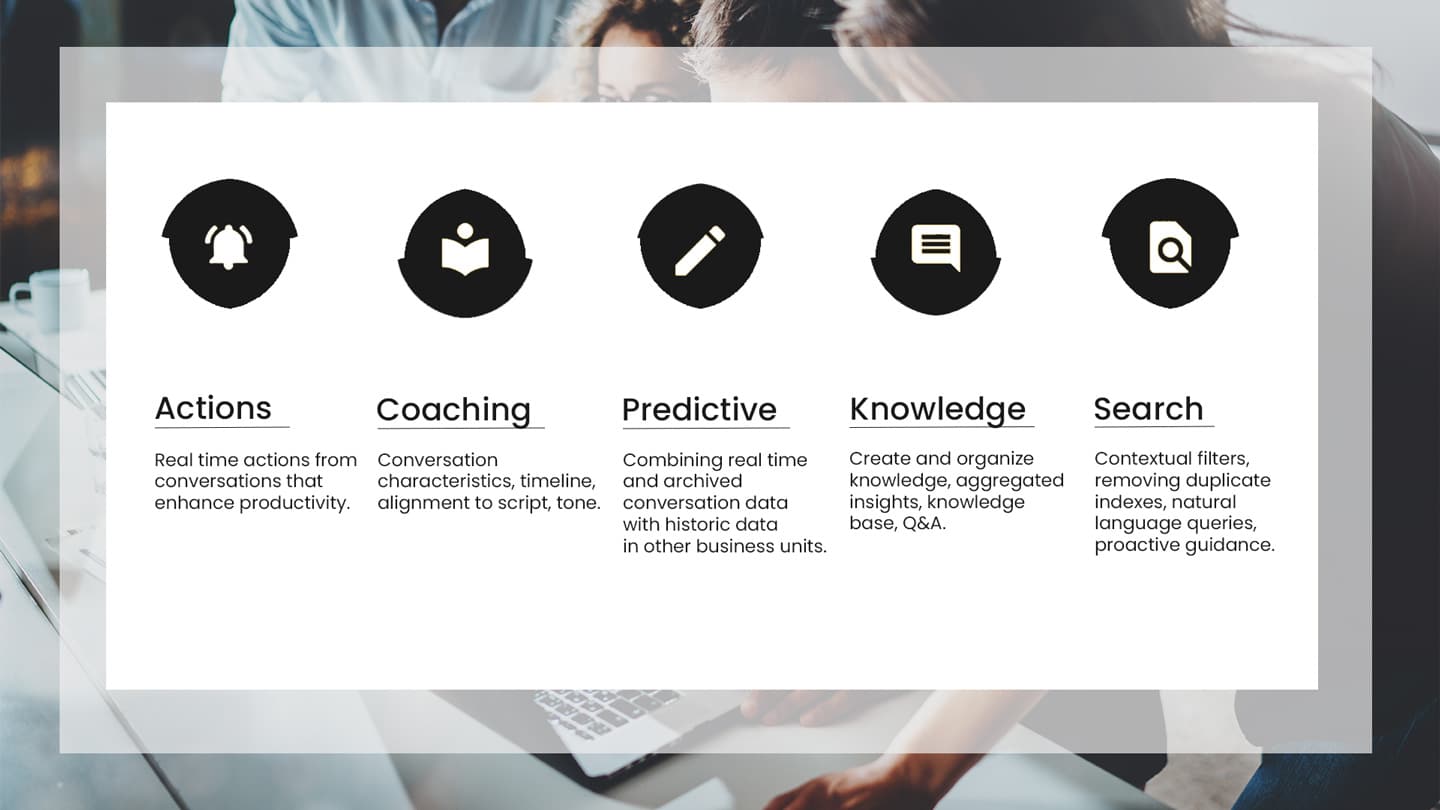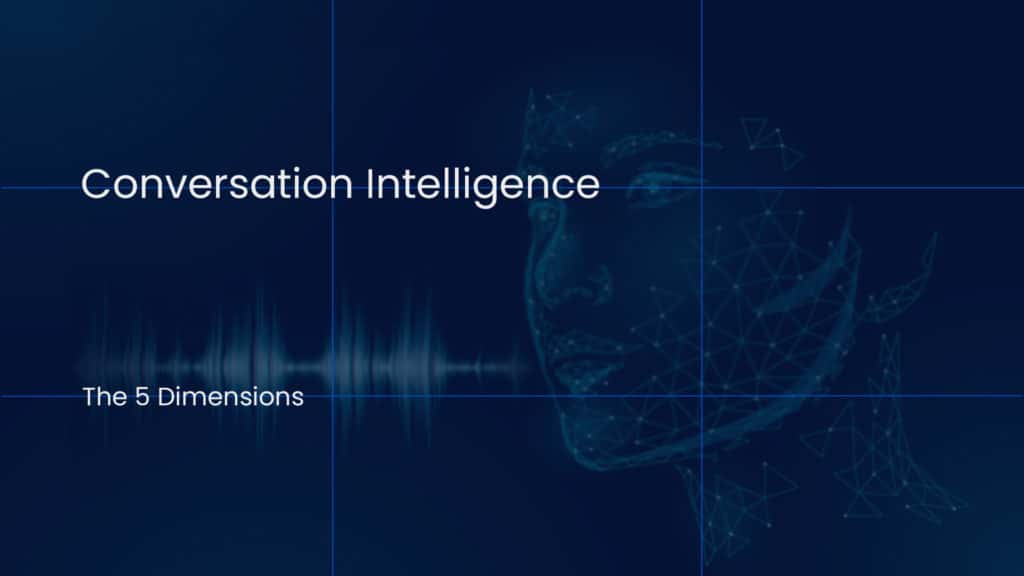There are five main ways in which conversation intelligence (CI) is currently being used or envisaged: real-time action, coaching, predictive analysis, knowledge, and search. All of these aspects of the CI landscape will come together to make humans smarter and more efficient, with little effort on the user’s part other than continuing to undertake natural conversations.
Conversation intelligence provides the ability to analyze natural human-to-human conversations in real-time. Going beyond simple natural language processing of voice and text conversations, mission-critical communications can be harnessed, analyzed, and optimized.
With conversation intelligence, you can create products that solve problems. As a developer, it’s useful to have an understanding of the overall conversation intelligence landscape so you can determine how you can strategically apply human conversation understanding into your applications.
This post will show you the five main areas in which conversation intelligence is used today.

1. Real-time actions
Conversation intelligence systems can be used to listen, understand, and propose actions based on what’s being discussed; such as workflow automations, sending information to other tools, system of records, and follow-ups. This enhances human productivity and saves time by doing manual repetitive tasks. A system that automates these actions in real-time opens up one of the most exciting and inspiring aspects of this AI.
You can create a platform for human-machine collaboration where the system recommends real-time actions which can trigger Robotic Process Automation (RPA) systems. This removes mundane tasks by automating them so humans can focus on critical decision-making instead. For example, invoice processing workflow – where your system can listen for tasks relevant to invoices that need processing, extract the required data from it, process the invoice, and submit it to an Enterprise Resource Planning (ERP) system.
Imagine bringing these ‘AI real-time actions’ into human to human (H2H) conversations: you don’t need to talk to a bot or train a system to understand common commands or a vocabulary, but instead there’s embedded intelligence in products that you use which passively listens to your conversations and trains itself. This intelligence enhances your productivity by recommending useful actions at just the right moment. For example, during natural conversation in a video call you’d receive real-time suggestions to email a question to another colleague, or the system would automatically do this for you.
So you see, real-time actions from conversation intelligence means we can look at the world through a different lens and alter how we think about the changing dynamics of communications and the workspace. Rather than you having to tell Alexa to add something to your calendar, the conversation intelligence system could listen to your natural speech and do it automatically.
2. Coaching
Conversation intelligence systems can be used to coach people, making them smarter, by maximizing their efficiency, skills, and knowledge.
In a sales context, your business client might want to know why their top five sales agents are so good. A conversation intelligence system can capture what they talk about in their sales calls, transcribe, and then use deep understanding to pull statistics, like tone, keywords, and the timing of certain phrases. Your client can then use this insight to train their sales agents and optimize their skills, time, and approach, as well as ensure compliance.
There’s a similar value for conversation intelligence in customer care industries, for example, where call center speech analytics can automatically surface interactions to review, and dig deeper into areas like supervisor escalations, dead air, and hold time. It can also employ voice sentiment analysis to learn what drives a positive or negative customer experience and scale the best practices of top agents.
By being able to review conversations and transcripts alongside evaluation forms, a conversation intelligence system can leave coaching tips for agents within a time-stamped transcript. If you use CI to provide contextual feedback and share results for wider team learning, this will create a focus on real skill development.
Another example of how it’s being used is public speaking coaching, where a conversation intelligence system can provide real-time feedback on key communication metrics, like pace, tone, filler words, energy, conciseness, confidence, and pauses.
3. Predictive analysis
Conversation intelligence systems can be built so they use historical data and current data to provide transparency in business forecasting and even specific functions like sales or customer support and predict next best actions more accurately and with broader context.
One such example is for sales: The ability to predict can be leveraged to maximize the potential of deals, known as deal intelligence. You could build a system that takes data from a CRM and looks at how many times a sales agent has interacted with a customer over four weeks, then combine that with the data from conversations to assess the overall outcome. Your system would be able use this information to predict whether a deal will close or not and enable your client to proactively unblock any obstacles.
In a call centre, predictive analysis can augment agents with recommendations based on historic data and real time conversations. Plus, it can improve customer experiences by accurately estimating customer flow to assess the correct call center capacity, highlight issues in real time, and trigger support or special offers to customers based on aggregated analytics. It can even ensure call center agents use their time more efficiently. For example, if a customer matches 90% of what a previous customer has said, the system will recognize it and predict whether it’s worth investing more time in that particular customer. Also, you can build proactive compliance monitoring, so that the conversation intelligence constantly monitors customer service agent phone calls, predicts where compliance gaps could arise, and provides action reminders.
4. Knowledge
Everyone has valuable information that can be converted into a knowledge base; whether it’s for an internal team or their customers.
Building chatbots to use this automated generated knowledge base from conversations across the organization can help scale redundant questions and save huge amounts of time invested in onboarding new employees and doing redundant meetings to gather information on older projects.
Imagine building a conversation intelligence system that can pull, recommend, use, and share relevant information from natural human to human conversations in real-time, so it’s surfaced at the exact moment that the user needs it.
Conversation intelligence can be particularly useful for finding hidden answers to questions. It can capture insights from emails, like internal project deadlines, or sales figures, and then maximize business efficiency by sharing that knowledge with other members of the team. It can also be smart enough to filter out sensitive information, distinguishing between personal details and business knowledge.
5. Search
An enormous amount of knowledge is shared by people talking. You can build a system that capitalizes on that so you can ask a question using natural language and the system can find the answer. For example, it can search conversations that have been recorded and analyzed, then surface the information in real-time.
There are two types of search:
- Direct search: You can ask questions in free-flowing natural language, like “What are the statistics of my team’s velocity?”, and the system will search through the knowledge base created from the conversation data and produce the answer.
- Indirect search or suggestion: The system can automatically do this in real-time based on what you’re saying and how you’re talking. For example, you can say “It would be interesting to know what the team’s velocity statistics are so we can…” and the system understands what information you need and provides the statistics.
To truly capitalize on the conversation data in any business, all of the tools from these categories need to come together. You’ll have noticed similarities in the different categories above, so it’s easy to see how if one aspect isn’t deployed then you miss out on the opportunity to fully optimize the intelligence.
Symbl.ai is taking conversation AI to the next level to enhance the conversation intelligence landscape and make it readily accessible to businesses around the globe. Symbl APIs are easy to implement as a plug-and-play on any communication channel. You get quicker results because they do not require any upfront training to generate insights and knowledge. You can use Symbl to integrate highly secure conversation AI in your client’s products and workflows. Learn more about the solutions that using Symbl brings.
